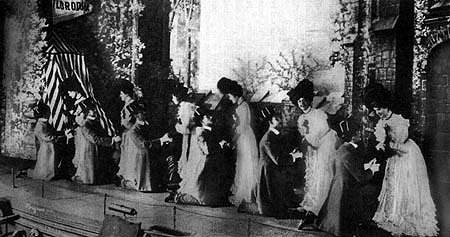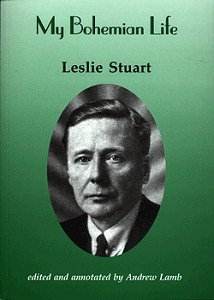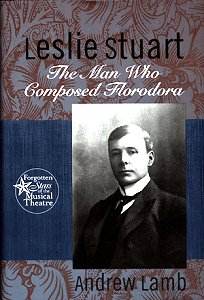This engaging biography gives valuable insight
into the rags to riches success of an important London theatre
music composer, originally known as Thomas Barrett of Manchester.
Along with Jones, Monckton and Rubens, Stuart was instrumental
in bringing about a wedding of music hall song and dance to spoken
dialogue providing the first English Musicals. When exported to
America, the Americans warmed to the style, but when staged in
France, the French did not at first know what to make of the genre.
Florodora was Stuart's unparalleled success,
and try as he could to repeat his successful recipe with this
showstopper he never quite equalled the grade. He did however
continue to write some very good songs, which towards the end
in America became outmoded when Ragtime took the spotlight.
Exploring the origins of a gifted musician is
always fascinating and in this respect Andrew Lamb has made an
excellent job. Like Sullivan (twelve years his senior) who Stuart
greatly admired, he began in humble surroundings and from backstreet
Manchester learnt to play the piano. Also like Sullivan, he became
a church organist. Whereas Sullivan stuck to orthodox tradition
Stuart was inventive and spiced up his liturgical music for choir
and congregation. His role as concert promoter is given excellent
and detailed treatment, with good information on the planning
of such concerts. The asides, like stories of artists that fail
to turn up, are fascinating. We get a clear picture of the singers
in demand at the time and the reasons for their popularity with
the public: Lamb has clearly researched this aspect carefully.
Stuart was largely self-taught one assumes for
we are given little insight into where he learnt all his musical
skills apart from tuition by a local piano teacher. There seems
to be a gap in knowing how he later made his jump to professional
status as a recitalist. An association with Charles Hallé
was effected and was probably cemented when Hallé, a fellow
Roman Catholic, worshipped at the church where Stuart was organist.
The social and domestic detail of Stuart family
life makes interesting reading. Clearly the money accrued from
Stuart's work in song-writing and as self-made concert promoter
led to a higher class of living; a large family with live-in servants
and a move from Manchester to London. It is in London where the
association with publisher David Day (Hunter, Day & Lewis)
took root. Unclear from biographies of other composers of the
period has been the perennial problem of underground pirate printers
producing street vendors with illicit sheet music for sale at
knockdown prices. Chappell, Cramer and Metzler must have all been
affected by the loss of income from this. This book records a
lot of detail for the first time. Lamb details the detective work
in hunting down pirate copies, their sources and the parliamentary
debates that followed. It all makes interesting reading.
We realise just how gifted Stuart was when it
takes only a few hours to produce a new song to add to an already
running musical, sometimes being motivated by employment of a
new star (and annoyance to the existing cast). We get little insight
into the method of putting a musical number together though. Often
the lyricist would be given the music to fit the words, an unsatisfactory
way of working. Stuart left the orchestral scoring to others like
Carl Kiefert, and the staff of theatre directors. Certainly, the
tight formula used by Gilbert and Sullivan to create a Savoy opera
was lacking at the Lyric and Daly's theatres, and there seems
to be a much freer relationship between cast and management. Yet
little expense was apparently spared in mounting a Stuart musical.
No anecdotes from the performers have been found to indicate the
level of order or disorder associated with the mounting of these
productions. Although additional numbers were added after a first
night there is no indication to suggest whether the dialogue or
existing music was reworked.
Peculiar to musicals is the regular inclusion
of additional numbers by other composers. How this habit came
about at this time is unclear. With Florodora for instance,
Rubens provided the lyrics to half the songs as well as the music
to 'I've an Inkling' and 'Queen of the Philippine Islands'.
Looking at the score of Florodora I find Stuart does not
provide an overture, just 8 bars of introduction. Likewise the
finale to Act II is a hastily written affair, a reprise of 23
bars with no introduction and only 4 bars of playout. This contrasts
significantly with the concerted and extended chorus finale of
Act I. Is this a characteristic of Stuart, I wonder? Was he too
busy with other things or had he become bored towards the score's
completion? It is also a mystery why Stuart would only conduct
the first Act of the show on a first night yet later with a different
show would spend two months of its run in the pit.
In the Leslie Stuart story we are rightly concerned
with the success of Florodora. We are provided with a detailed
synopsis, the content of numbers, who sang them, and the critics'
appraisal of productions as we are for all the following musicals.
The financial backing of Stuart's first production must have been
immense and added to the success of the staging.
The elegant costumes were an extravagance and
no expense had been spared in employing the leading London set
designer/painters, Hawes Craven, who had provided Sullivan's Haddon
Hall and Ivanhoe scenery that was much admired. It
is unclear whether this was transported to New York for the American
run since the American backers were unsure of the show's success
there. A picture of the original run would have been preferred
to the illustration provided in the book for the New York run
.

Pic: Florodora,
New York 1901 (Notice the cramped stage with little depth)
Stuart lived beyond his means, became bankrupt.
Although composing to the end, musical theatre had moved on and
it was the turn for Kern, Porter, Berlin, Ellis, Novello and Coward
to take the limelight.
A foreword by Kurt Ganzl seems misplaced for
it reads more as an advertisement for other books in the series
and takes the focus away from consideration of the book in question.
So much use of the first person also tends to detract from support
for the author, which is surely a preface's intention. The book
is handsomely printed but the photographic material has suffered
a flatness in its transfer to fibrous paper and underinking.

Stuart produced an interesting autobiography (pp.135) in 1927
which has been reprinted with index by Fullers Wood Press with
forward and annotations by Andrew Lamb. This is available from
email: andrew-lamb@fullerswood.fsnet.co.uk
for £13 (UK), £14 (Europe) and £15 (USA/Australia)]
Raymond Walker

